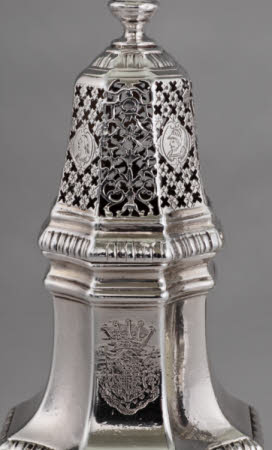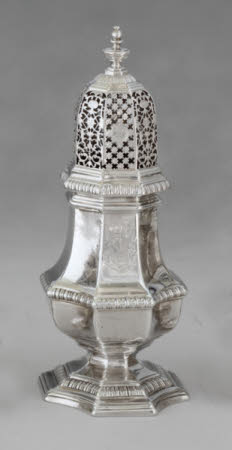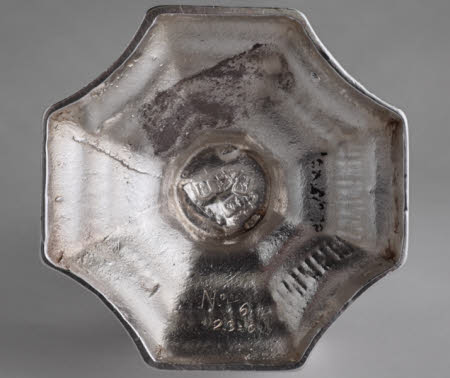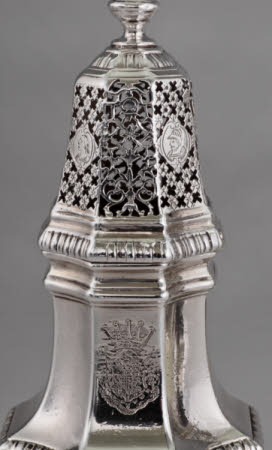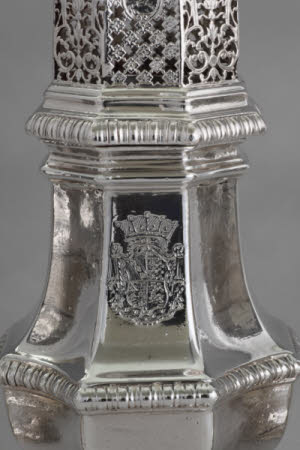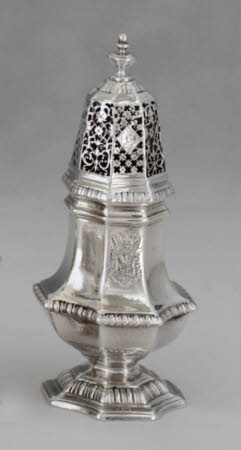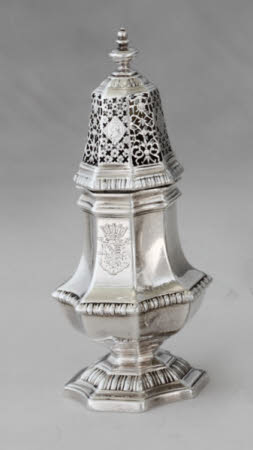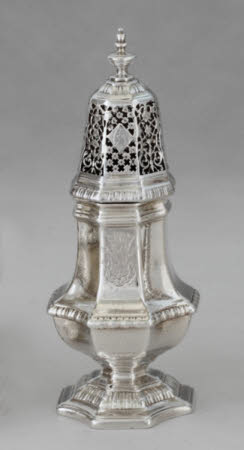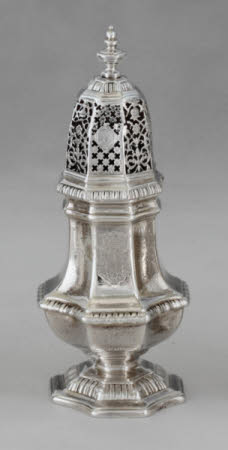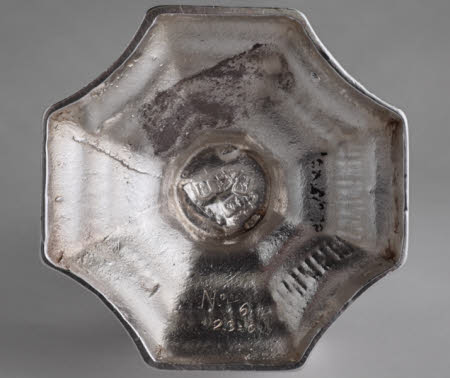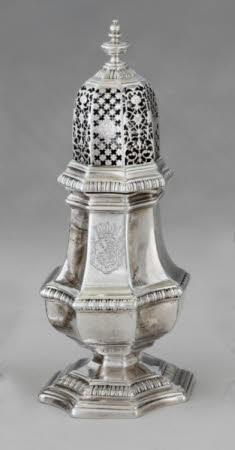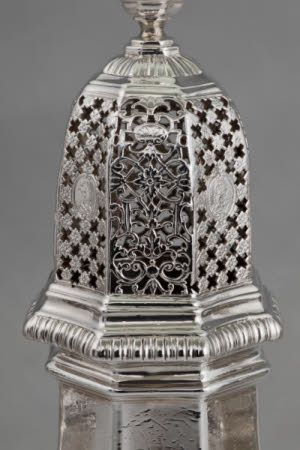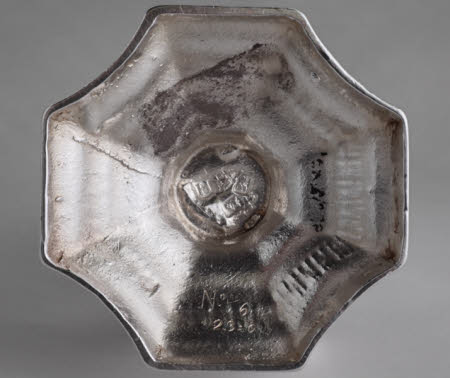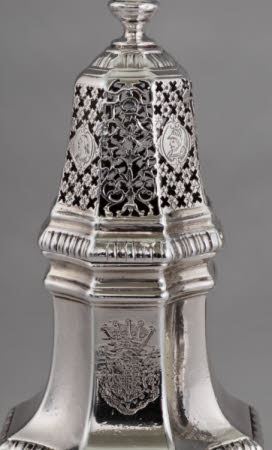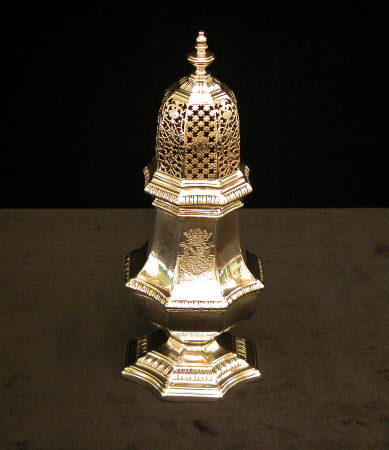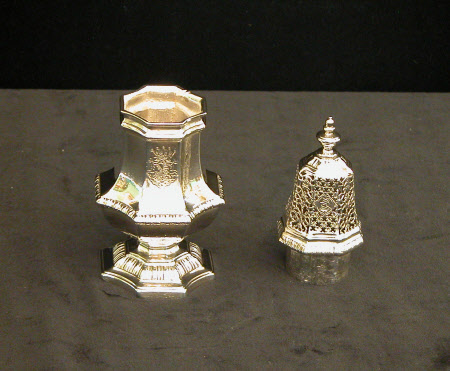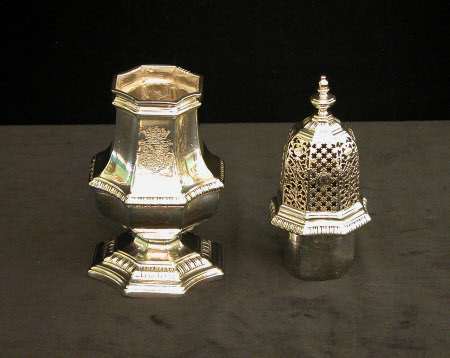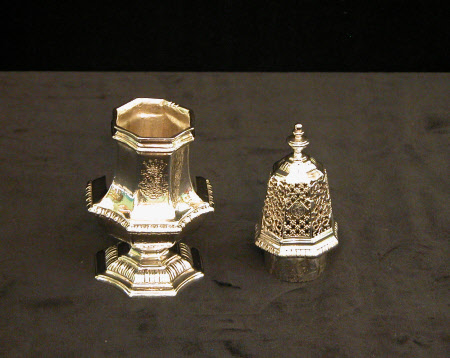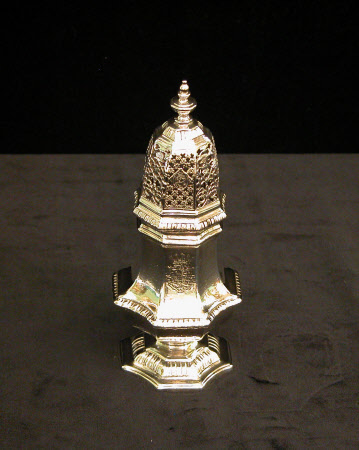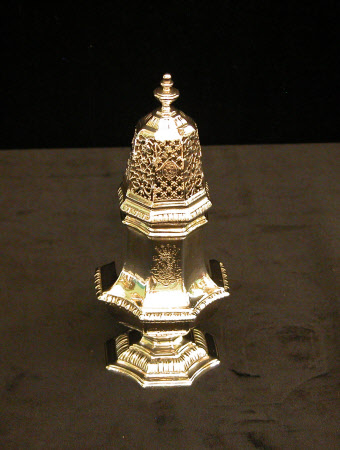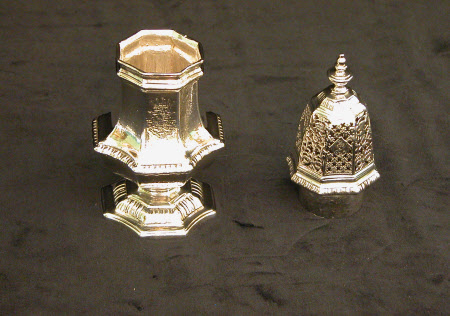Six casters from an epergne
Paul de Lamerie (1688 - London 1751)
Category
Silver
Date
1723 - 1724
Materials
Silver
Measurements
21.6 cm x 8.6 cm (2); 16.2 cm x 6.7 cm (4)
Place of origin
London
Order this imageCollection
Ickworth, Suffolk
NT 852084
Summary
Six Britannia silver casters from an epergne, by Paul de Lamerie, London, 1723/4. The baluster-shaped casters are entirely octagonal in plan, the sides alternately incurved and straight from the foot through to the piercings of the covers. The upper part of the covers is also octagonal but without any incurving. The spreading feet are cast in one piece and the bodies in two vertical halves, with chased gadrooning on the foot and at the waist. The high-domed covers have seamed bezels and cast rims with chased gadroon borders. Above on each are eight panels soldered together, pierced and engraved with alternating designs of foliate strapwork and trelliswork with C-scroll oval bust medallions. The busts represent classical deities, one bearing the crescent of Diana and another in armour and a helmet probably being Mars. The covers culminate in cast and chased gadroon caps and baluster finials. Heraldry: Each caster has been re-engraved c.1751 on one of the flat sides above the waist with the quartered shield of the 2nd Earl of Bristol in an ermine mantling and beneath an earl’s coronet. Hallmarks: Each fully marked on the underside with maker’s mark ‘LA’ star and closed crown above fleur-de-lis below (third mark, unregistered – see Susan Hare (ed.), Paul de Lamerie, At the Sign of the Golden Ball, London, 1990), Britannia, lion’s head erased, date letter ‘H’. No. 6 has the maker’s mark struck twice, partly obscured by the other marks. Scratchweights: ‘No 1 [/] 14=8’; ‘No 2 [/] 12=15’; ‘No 3 [/] 24=16’; ‘No 4 [/] 12=6’; ‘No 5 [/] 12=12’; ‘No 6 [/] 23=0’.
Full description
THE SCARSDALE EPERGNE On 1 April 1737 Lord Bristol noted in his accounts that he ‘Paid Christopher Cock ye Auctioneer in full for a silver Epargne weight 497 ounces, 12d weight at 6s.08½d pr ounce, bought at Ld Scarsdales sale [£]166:17[s]’. These six casters, two cruet frames (NT 852085) and an oval dish (NT 852064.1) are what remain of that epergne and all are by Paul de Lamerie. It is possible, in addition, that the four waiters bearing the mark of Lewis Mettayer and re-shaped in the 1750s by Kandler (NT 852097) might also have been part of it. The original appearance of the whole is suggested by the two surviving intact epergnes of this sort, that for the Williams family of 1730 predominantly by Edward Feline and George Wickes and now in the collection of the National Museum, Wales [1] and the other of 1731 by David Willaume and Anne Tanqueray from Kirkleatham in Yorkshire. Relating to the latter, James Lomax has given a comprehensive assessment of the evolution and use of these monumental centrepieces in his catalogue of the silver at Temple Newsam where it now resides.[2] Nicholas Leke, 4th Earl of Scarsdale (c.1682–1736) had succeeded to the title and to Sutton Scarsdale in Derbyshire on the death of his uncle, a prominent Jacobite, in 1707. As a staunch Tory himself and a close associate of Robert Harley, 1st Earl of Oxford, he rose to some prominence in the second half of Queen Anne’s reign. In 1710 Scarsdale was appointed Lord Lieutenant of Derbyshire in place of his principal Whig rival in the county, the 2nd Duke of Devonshire,[3] and in 1712 he was named Envoy to the Holy Roman Emperor, though his departure for Vienna was to be delayed until the outcome of the Utrecht negotiations was known. He never in fact went, but remained in favour and in July 1713 he was the peer designated to receive the French ambassador, the Duc d’Aumont, at his public entry into London. On the death of Queen Anne he was dismissed from the Lord Lieutenancy, Devonshire returning to the post, and implication in the Jacobite rising led to him being taken ‘under a strong guard’ to the Tower of London in October 1715.[4] He was not bailed until the following May and after a few years of keeping a low profile he began in 1724 to rebuild the family seat in a grandiose manner. His architect was Francis Smith of Warwick and the interior was lavishly finished, the exuberant stuccowork being by the Italians, Alberto Artari and Francesco Vassalli.[5] At the same time as Lord Scarsdale was erecting his splendid new house he was also embellishing his store of plate by the purchase of at least two pieces from Paul de Lamerie. The first was the epergne subsequently acquired by Lord Bristol and although the Leke family papers are not known to survive, Scarsdale fortuitously banked with the forerunners of Goslings and their ledgers from 1718 are still in existence in the Barclays Bank archive. On 26 August 1725 the Earl is recorded as having paid £150 to ‘Paul Delamiere’ and that is very likely to have been a part payment for the epergne, given the dates of manufacture of the surviving pieces (1723 and 1724). The remainder is probably the £100 to ‘Mr. Lemerie’ which followed on 4 March 1726 as the total price would have been £250 10s, or thereabouts.[6] This figure, equating to at least £35,000 today,[7] is based on the 1718 charges per ounce of 5s 8d for the silver and 3s 6d for fashion, plus £10 for engraving, of Lamerie’s epergne for Thomas Coke of Holkham, added to which is the 6d per ounce duty payable from 1720.[8] The epergne must have been spectacular enough but the Earl of Scarsdale’s other principal purchase from de Lamerie is one of the most monumental and striking objects in silver to survive from the first quarter of the eighteenth century: a massive cast and chased silver cistern of 1726 with winged female masks representing plenty, extravagantly modelled armorial assemblages (the Scarsdale arms subsequently covered over) and weighty scroll and female term handles.[9] At 2,646 ounces this piece would have cost well over £1,000, which is symptomatic of Lord Scarsdale’s reckless spending in the last fifteen years of his life. Both epergne and cistern would undoubtedly have been on display at the ‘Grand entertainments’ he gave, such as that on 29 May 1729 ‘to divers of the Nobility and Gentry, at his House in Duke-street Westminster’, and may also have been amongst his baggage when he progressed from London to Sutton Scarsdale ‘with a great Retinue’ in September, 1731.[10] By the time of his death six years later he had run up enormous debts and both Sutton Scarsdale and the silver had to go to meet them.[11] Lord Bristol bought the epergne and the cistern ended up in the collection of the Empress Anna of Russia’s favourite, Ernst Johann von Biron, Duke of Courland, and is now in the Hermitage.[12] Even if Bristol had not attended any of the ‘grand entertainments’ in Duke Street, within a few hundred yards of his own house in St James’s Square, he is likely to have heard reports of the magnificence of its furnishing and as an avid buyer of second-hand plate he would have been alert to the opportunities offered by the sale. Only three full-scale epergnes, comprising a central tureen, casters, cruet frames, saucers and candle arms, were supplied by George Wickes between 1738 and 1743 and they were charged at 9s 7d, 9s and 9s 2d per ounce plus additional costs for elements such as the cut-glass bottles, silver mounts and a case.[13] The second-hand purchase, at 6s 8½d, therefore saved the Earl of Bristol at least £55 and possibly up to £70. The Scarsdale epergne was only a little over a decade old in 1737 and would have more than held its own on the dinner table. Though the Rococo was beginning to take hold, decoration up to the mid-1730s continued to be mostly Régence in its inspiration and the surviving centrepiece from a 1734 epergne by de Lamerie in the Metropolitan Museum in New York has the same female masks, classical busts, diaper-work, shell motifs and tied reeding seen on the Scarsdale cistern and probably also present on the lost elements of the epergne.[14] The oval dish of the 1734 model, as well, is very close in form and decoration to the Ickworth one, and cruet frames continued to be made to an almost identical model into the 1740s.[15] Casters, including de Lamerie’s, were mostly round by the 1730s, as on the Kirkleatham epergne, but still sometimes supplied as octagonal. However good a deal the epergne was in 1737 its life thereafter was to prove short, as by the time the 2nd Earl of Bristol inherited in 1751 such ponderous multi-purpose concoctions were being replaced with lighter affairs, restricted to a central basket, surrounding saucers and occasionally also candle arms, and associated primarily with dessert. These ‘epargnes with 4 saucers & a basket’, as George Wickes frequently termed them, had been around for many years, previously often described as ‘machines’, but from the late 1740s they were the subject of a positive craze and swept aside their mighty predecessors, most of which ended up being turned in to be melted. This must have been the fate of the Scarsdale epergne though, as in many other cases, the central dish, saucers, casters and cruets, which were all demountable and were designed to work visually as separate units as well as with the whole, were retained though not necessarily for their intended uses. The 2nd Earl received a new epergne in 1759 as part of his perquisite plate when Ambassador to Spain. It weighed just 157oz 10dwt, and was no doubt spidery and lace-like with an inverted trumpet stem and a boat-shaped central basket, as was the fashion by then.[16] Contemporary examples from the period include two by William Cripps of 1757 and 1758. The former weighs almost exactly the same as did Lord Bristol’s whereas the latter, of the same form but without candle arms, is considerably lighter.[17] There was no epergne surviving amongst the Bristol plate by the time the 5th Earl (future 1st Marquess) recorded his collection in 1811 and it is likely that it had been taken by his father, the Earl-Bishop, either ending up at Downhill, County Londonderry or, if it was amongst the plate he travelled with in Europe, being seized along with his accumulated artworks by the Napoleonic army in Italy in 1798. THE CASTERS Whilst part of the complete ensemble these casters would have rested on projecting platforms as seen on the Williams and Kirkleatham epergnes. Sets of three casters were produced in substantial numbers from the end of the seventeenth century, the larger one being for sugar and the smaller pair for pepper and mustard. This allocation is clearly articulated in Lord Warrington of Dunham Massey’s manuscript plate list of 1750/4.[18] The cover of the caster for mustard was either supplied with a liner or left blind (unpierced) as the condiment was served dry in the eighteenth century to preserve its flavour. There are frequent mentions in the Wickes ledgers of mustard and sometimes pepper glasses – presumably liners for the casters – and there were also accompanying silver mustard spoons which must have projected into the covers. Eight glasses (spares always seem to have been provided) and two spoons, for instance, accompanied Everard Fawkener’s surtout in 1735, and the following year Colonel Cornwell received six glasses and ‘a large Mustard Spoon’ with his set of casters.[19] None of the Ickworth casters appears to have been blind, so it is probable that those for mustard were fitted with liners. Casters from the last decades of the seventeenth century are generally of the straight-sided cylindrical type such as those supplied to the 2nd Earl of Warrington c.1695 by Daniel Garnier.[20] The circular baluster is seen in a design for a parcel-gilt sucrier for Louis XIV of c.1700,[21] and at around the same time the form was established in England, as in the particularly magnificent set of three gilt casters, probably by Philip Rollos I, supplied to Lord Raby in 1705 on his appointment as ambassador to the King of Prussia.[22] By 1720 the octagonal baluster held sway and continued to do so up to the early 1730s when the round form began to dominate again. Casters of the 1720s were for the most part devoid of decoration apart from moulded wires and the piercing of their covers. That was not the case for those supplied with Lord Scarsdale’s epergne, however. Not only is their piercing particularly impressive and intricate, as well as being enhanced by engraving, but they are also gadrooned and demonstrate a variation on the standard planform, with alternately incurving sections to the octagon. These run right through the caster from foot to top of cover, giving greater movement and interest and being perhaps the earliest surviving example of an extremely rare feature. Other known representations are on the gilt casters of 1727 by Paul Crespin supplied to the Earl of Chesterfield for his embassy to The Hague and a small pair of 1730 without maker’s marks engraved with a ‘G’ monogram beneath an earl’s coronet.[23] All of these casters share very similar or identical patterns of piercing to their covers, as do others of the period including the set of three of 1725 by de Lamerie in the Museum of Fine Arts, Boston.[24] The same specialist subcontractor may well have been involved with the whole group. Having survived the melting of the body of the epergne, the casters continued in regular use right up to the death of the 4th Marquess of Bristol in 1951, hence their considerable wear. Latterly the bases had been used on their own as mustard pots and the covers lay forgotten in an attic, though fortunately not discarded.[25] James Rothwell, Decorative Arts Curator December 2020 [Adapted from James Rothwell, Silver for Entertaining: The Ickworth Collection, London 2017, cat. 11, pp. 79-82]. [1] National Museum Wales, nos. NMW A 51194 and 51709-12, on display at Bodelwyddan Castle. Last sold at Sotheby’s New York, 19 October 1995, Lot 454. [2] James Lomax, British Silver at Temple Newsam and Lotherton Hall, Leeds, 1992, cat. 81, pp. 87-91. [3] https://en.wikipedia.org/wiki/Lord_Lieutenant_of_Derbyshire, accessed on 31 October 2015. [4] Post Boy, 2–4 October 1712, Issue 377; British Mercury, 5 November 1712, Issue 383; London Gazette, 30 June–4 July 1713, Issue 5134; Flying Post, 11–13 October 1715, Issue 3709 and 26–9 May 1716, Issue 3807. [5] Maxwell Craven and Michael Stanley, The Derbyshire Country House, Ashbourne, 2004, pp. 216-7. [6] Barclays Group Archive, Gosling and Sharpe’s Bank and its predecessors 1718-1809, Ledger 130/8, ff. 276 & 338. [7] Calculated using the converter on https://www.measuringworth.com. [8] D. P. Mortlock, ‘Thomas Coke and the family silver’, Silver Society Journal, no. 9 (1997), p. 556 and Anthony Dove, ‘Plate duty. Its origins, marks and variations’, Silver Studies, no. 22 (2007), p. 105. [9] Marina Lopato, State Hermitage Museum Catalogue, British Silver, New Haven & London, 2015, cat. 26, pp. 85-90, ill. As discussed by Lopato there is a possibility that a pair of chandeliers by de Lamerie of 1724 in the Kremlin may also have been Scarsdale’s. [10] Daily Journal, 30 May 1729, Issue 2619 and Daily Advertiser, 6 September 1731, Issue 185. Other entertainments given by Lord Scarsdale were reported in the London Journal, 21–28 May 1720, Issue 44, commemorating his release from the Tower, and in the London Evening Post, 7–9 Nov 1728, Issue 144, marking his birthday. [11] Craven and Stanley 2004 (see note 5), p. 217. [12] Lopato 2015 (see note 8), p. 90. [13] National Art Library, V & A, Garrard Ledgers, VAM 1 1735–40, f. 193, 1740, Viscount Duncannon, f. 182, 15 February 1739, Earl of Macclesfield and VAM 2, f. 69, 16 August 1742, Joseph Ledson. [14] Metropolitan Museum, accession no. 58.7.2 a-j. [15] See for instance the cruet frame and bottles of 1742 by George Wickes sold at Sotheby’s, 21 February 1980, lot 163, also illustrated in Elaine Barr, George Wickes: Royal Goldsmith 1698-1761, London, 1980, p. 74, fig. 37. [16] The National Archives, LC 9/45, Jewel Office Delivery Book 1732–93, f. 165. [17] Christie’s, 23 May 1990, lot 167 and 13 June 2001, lot 112. [18] James Lomax and James Rothwell, Country House Silver from Dunham Massey, London, 2006, pp. 128 and 175. By 1750 Lord Warrington had an epergne with six casters, a cruet frame with three and an independent set of four, the latter being specified for sugar (the two large), pepper and mustard (the two small). [19] Garrard Ledgers (see note 12), VAM 1 1735–40, ff. 38 and 69. [20] Bonhams, 12 November 2014, lot 115. This set of three casters, one large and two small, with superbly patterned piercing to the lids, had been relegated to the servants’ table by 1750. See Lomax and Rothwell 2006 (see note 17), p. 170. [21] Versailles et les tables royale en Europe, Paris, 1993, p. 128, ill., and Beth Carver Wees, English Irish & Scottish Silver at the Sterling and Francine Clark Art Institute, New York, 1997, cat. 125, pp. 212-3. [22] Patrick Eyres and James Lomax (eds), Diplomats, Goldsmiths and Baroque Court Culture: Lord Raby in Berlin, The Hague and Wentworth Castle, Barnsley, 2014, pp. 68 and 75. [23] Christopher Hartop, The Huguenot Legacy: English Silver 1680-1760, London, 1996, cat. 10, pp. 108-9. The 1730 pair were sold by Wax Antiques, 49 Camden Passage, London N1 8EA - http://www.waxantiques.com/antique-silver/d/pair-of-george-ii-silver-casters/170730. [24] MFA, Boston, acc. no. 2001.47. See also Hartop 1996 (see note 22), cat. 24, pp. 158-61. [25] N. M. Penzer, ‘The Hervey Silver at Ickworth’, Apollo, vol. 65 (Feb & Apr 1957), II, p. 134.
Provenance
Nicholas Leke, 4th Earl of Scarsdale (d. 1736); 1st Earl of Bristol (bought, as part of an epergne, 1737, at the Scarsdale sale); by descent to the 4th Marquess; accepted by the Treasury in lieu of death duties in 1956 and transferred to the National Trust.
Credit line
Ickworth, the Bristol Collection (National Trust)
Makers and roles
Paul de Lamerie (1688 - London 1751) , goldsmith


